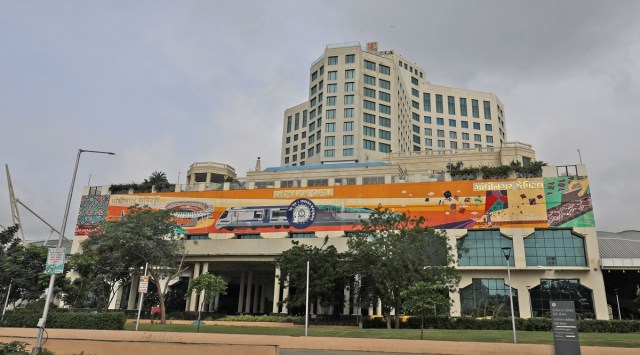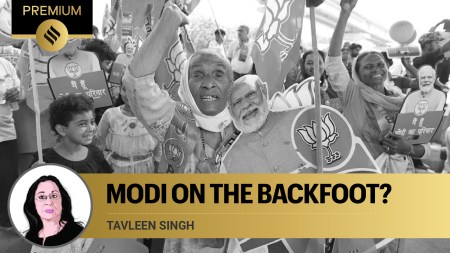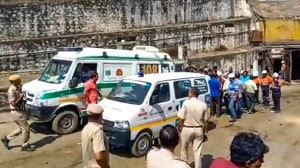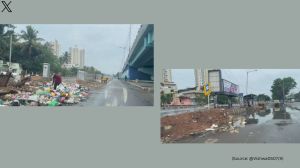- India
- International
Hardlook: Why Gujarat’s capital city — a greenfield project of the ’60s — stands on a cusp
On August 2, Gandhinagar city celebrated its 59th foundation day.
 Hotel Leela and railway station near Mahatma Mandir.(Express File Photo)
Hotel Leela and railway station near Mahatma Mandir.(Express File Photo) Eighteen years back, Pradip Solanki (59) moved to Gandhinagar’s Kudasan village, now a part of the municipal corporation, from the Himmatnagar town where he was working at a bank. Now a branch manager, he volunteers as a “snake rescuer”, and claims to have saved around 1,800 snakes so far. The feat also underlines a wild side of the otherwise sectorally planned city inspired by Chandigarh.
“Gandhinagar was a jungle of sorts before the city was developed. I believe snakes play a major role in the ecological balance by controlling the rat population. So, it has been my passion to rescue snakes and release them in the wild, unharmed,” Solanki says. He moved to the city in order to ensure access to educational institutes for his son and daughter.He was also attracted by the tranquility and “less busy roads”. For some years, Solanki, originally a resident of Ahmedabad, continued commuting to Himmatnagar from Gandhinagar to work before he was finally transferred to the city.
A look back
Located 24 km north of Ahmedabad, Gandhinagar has no romantic story of its foundation buried under the ruins of a fort, unlike Ahmedabad – the lore of the Sultan Ahmed Shah establishing a city “where he saw a rabbit taking on a hare” is legendary. Moreover, unlike Ahmedabad, which has a mix of horizontal and vertical growth, Gandhinagar has no high-rises yet.
In his book — ‘The Building of Gandhinagar – New Capital of Gujarat: India’ – the city’s assistant town planner, Prakash Apte, writes how even before Gujarat split from a united Bombay State on May 1, 1960, the Chief Minister-designate, Dr Jivraj Mehta, had declared on March 19 that year that the new capital would come up “about 24 km north of Ahmedabad”, and would be called Gandhinagar — after Mahatma Gandhi.
 The city was built by chief town planner Hargovind Mewada and his assistant Apte, both having been trained under Swiss architect Le Corbusier on the Chandigarh project in the 1950s. (Express Photo by Nirmal Harindran)
The city was built by chief town planner Hargovind Mewada and his assistant Apte, both having been trained under Swiss architect Le Corbusier on the Chandigarh project in the 1950s. (Express Photo by Nirmal Harindran)
But nothing moved till 1964 as the Oil and Natural Gas Commission (now Corporation) was exploring the area for oil. In July 1964, it declared the area free of oil, and a separate Circle (engineering division) was formed under a Superintending Engineer, P.W.D. (Public Works Department) for the preliminary survey works and execution of the project, Apte writes.

The city was built by chief town planner Hargovind Mewada and his assistant Apte, both having been trained under Swiss architect Le Corbusier on the Chandigarh project in the 1950s.
The state government approved the plan for Gandhinagar city in 1966. The first stone to build a rest house in the notified capital region had already been laid on August 2, 1965. The rest house was later handed over to the erstwhile Gujarat Electricity Board, now Gujarat Urja Vikas Nigam Ltd (GUVNL), in July 1974. Currently, the building is a part of Gandhinagar Thermal Power Station Colony in Sector 30, designated as a VIP guest house, and is the customary venue to celebrate Gandhinagar’s foundation every year. Eventually, the capital was shifted from Ahmedabad to Gandhinagar in 1970.
Between 1966 and 1970, the Secretariat Building (now the Old Secretariat), Legislative Assembly Building (now the building of Central Library of Gandhinagar), MLA Hostel Government Printing Press, Pathik Ashram- a visitors’ hostel, primary and secondary schools, VIP and staff housing were built in the city. The current assembly building – Vithhalbhai Patel Bhavan – was built later and inaugurated in July 1982. As Apte records, Pathikashram was built adjoining the main city bus terminus to provide lodging and boarding facilities at reasonable rates to the visitors to the capital.

Till the turn of the century, for those living in Ahmedabad Rajshri Cinema in Sector 21 was the only luxury movie-watching experience with its plush red carpeted floor, and reclining seats, although Gandhinagar’s first movie theatre was Asha Theatre. City Pulse in Kudasan was the first multiplex between the two cities, where a live band played outside it on weekends as visitors from Ahmedabad, Gandhinagar, and around, dined at the bistros. Rajshri Cinema has closed down, while City Pulse has several competitors in Ahmedabad.
Planned for a population of about 1.50 lakh, Gandhinagar first covered around 54 sq km area after acquiring land from 12 villages. The last expansion was in 2020 when 18 villages were included in the municipal corporation. The city now measures around 194 sq km, which is equivalent to the 600-plus-year Walled City part of Ahmedabad (191sq km), which boasts of UNESCO’s World Heritage City tag. Ahmedabad today measures 466 sq km with an estimated population of over 60 lakh.
 The plank commemorating the laying of foundation stone. (Express Photo by Parimal Dabhi)
The plank commemorating the laying of foundation stone. (Express Photo by Parimal Dabhi)
The Sarkhej Gandhinagar Highway, now called SG Road, is the most popular link between Ahmedabad, the trade capital, and Gandhinagar the political capital of Gujarat. River Sabarmati runs through Ahmedabad and past Gandhinagar and the Riverfront Project will eventually connect the two cities. The Ahmedabad-Gandhinagar bullet train, which now runs on a 32 km network within Ahmedabad, is also expected to connect to Gandhinagar in the second phase.
What’s loved, what’s not
Pradip Solanki is happy about the administration promoting tree plantation to compensate for the lost green cover to infrastructure development. “But I would really like it if the local transport service is improved, and city buses reach the internal parts of the city as well,” says Solanki who commutes to work in his car. The capital city has only one private bus service plying on various routes, and private taxis in the absence of public transport. The city has largely been preferred by bureaucrats, politicians, and state government employees.
Vaibhav Parikh (29) was born in Gandhinagar. His mother worked at the Women and Child Development Department and the family moved from Kadi in Mehsana district to Gandhinagar in the 1980s after they were allotted a residential plot at concessional rates along with house building allowance (HBA).
Like Solanki, he likes the city for its perks of “less traffic, low population density, low crime rate, security, cleanliness, and no hustle bustle but a peaceful life”. “For leisure and other purposes, we visit Ahmedabad once a week”, he says.
Additional Chief Secretary (Labour, Skill Development and Employment Department) Anju Sharma has had three stints of stay in Gandhinagar, beginning as the District Development Officer (DDO). She finds it “cleaner, healthier, calmer, less populated and peaceful” than Ahmedabad. “In big cities, like Delhi and Gurugram, you have to travel even more for say leisure or other purposes,” she shares. Her latest spell of stay has been the longest since 2009.
Referring to the 2020 expansion of the city, Sharma says, “With these areas developing soon there will be several options of entertainment, clubs and services created around Gandhinagar.”
Rajendra Patel, a 25-year-old PhD student at Central University of Gujarat (CUG) since 2021, originally from Jodhpur (Rajasthan). He says the city is expensive for a student but the quality of life is better than other cities. “We visit Ahmedabad once a month to go to malls,” he says.
Ishita Jhala, another PhD student at CUG, hails from Vadodara. She has stayed in cities like Bengaluru as a student and for work. She rues that the bicycle-sharing service that was started after the pandemic was discontinued.
Spot the odd
While governments vie to name roads after political and national heroes, Gandhinagar had named its roads after Gujarati alphabets. The inner city roads are named after the Devnagri alphabets along the North-East and South-West axis while the curved road along river Sabarmati is called ‘Ja’. The other roads take after alphabets ‘Chha’, ‘Ch’, ‘Gh’, ‘G’, ‘Kh’, and ‘Ka’. The roads along the North-West and South-East axis have numbers 1 to 7, highlights Apte in his book. Apte explains how the road alignment was designed to evade the sun for road users.
Smart City
After being notified, various urban services were being provided by the Capital Project division of the Roads & Buildings Department and other departments of the state government. The state government, following a Gujarat High Court order of September 17, 2009, declared Gandhinagar a municipal corporation on May 1, 2010.
The development came soon after the then CM Narendra Modi announced that the GIFT City, India’s first greenfield smart city, was coming up in Gandhinagar district. GIFT City, sandwiched between Ahmedabad and Gandhinagar, is also equidistant from the two. The plan is to develop the three on a “tri-city” concept. Even after becoming a municipal corporation, except for sanitation, most of the services are being operated and maintained by the state government. Gandhinagar Municipal Corporation (GMC) Standing committee chairman Jashwant Patel says since the delimitation in 2020, the annual budget has gone up from Rs 264 crore (in 2021-22) to Rs 544 cr in 2022-23 to Rs 945 crore in 2023-24.
Currently, GMC has 11 wards (four councillors in each ward) and the city is divided into three zones – north, central, and south. Real estate developers in Gandhinagar however, say that most of the new real-estate development happening is clusters of Raisan and Kudasan clusters outside the city.
Gandhinagar is also among the six smart cities of Gujarat that figure in the list of 100 smart cities. However, it has fewer projects compared to Ahmedabad, Surat, Rajkot, and Vadodara under the Smart City Mission.
Political outlook
Gandhinagar city is part of the Gandhinagar Lok Sabha constituency that has been represented by prominent leaders in Parliament. Former deputy prime minister and BJP leader LK Advani was its MP for five terms, former PM Atal Bihari Vajpayee represented it once, and former chief election commissioner TN Seshan chose this constituency to fight his first election on a Congress ticket in 1999.
The local elections to the Gandhinagar Municipal Corporation (GMC) have always seen a close fight. Congress won the first election in 2011, but its mayor Mahendrasinh Rana defected the following year to the BJP, with two other councillors. The next election in 2016 to 32 seats witnessed a tie between the parties winning 16 seats each. Again the Congress candidate Pravin Patel defected to the BJP and was announced its mayor. In the third general elections of the GMC held in 2021, the BJP secured a landslide victory while winning 41 out of the total 44 seats post the delimitation of the urban body. Congress won two and first-timer Aam Aadmi Party (AAP) won one seat. The current mayor is Hitesh Makwana, and the seat is reserved for Scheduled Caste as per the roster.
Future Potential
As a CM, Keshubhai Patel’s stamp bears on the Gujarat InfoCity project that took shape in 2000. It was the first attempt to attract Information Technology firms in Gandhinagar, the project for which was awarded to Florida-based Creative IT Inc in a joint venture with the state-run Gujarat Informatics Ltd. Populated largely by call centres, KPO and BPO firms and spread over 150 acres, the project employs about 25,000 persons. A decade later, the IT/ITES sector in Gandhinagar got a larger boost when Tata Consultancy Services (TCS) announced the launch of a 10,000-seat campus called Garima Park near InfoCity Campus in November 2013. The project spread over 25 acres was inaugurated by then-chief minister Narendra Modi.
Chairman of the High Level Committee (HLC) of urban planners constituted by the Ministry of Housing and Urban Affairs Keshav Varma, a retired Gujarat cadre bureaucrat who briefly lived in the old Gandhinagar, believes it can be developed as a “charming place”.
“Gandhinagar has great potential because it is already sitting in the heart of nature. In cities and megacities, citizens are living with a very high AQI but Gandhinagar must have a low AQI which is very rare for a capital city,” says Varma, who is also chairman of Sabarmati Riverfront Development Corporation (SRFDCL) Ahmedabad and former sector director at the World Bank.
“With aspirational planning including GIFT City, Olympic preparations, and riverfront project, it can be developed into a world-class city as it is already a green city and should be positioned in that way,” he added.
The municipal corporation is building four model roads, for which HCP Designs, Planning and Management Private Limited (HCPDPMPL), which built the Central Vista at Delhi, has been awarded the project last month. The firm of Ahmedabad-based architect and urban planner Bimal Patel the Chief Minister’s Office in Gandhinagar.
May 15: Latest News
- 01
- 02
- 03
- 04
- 05






































